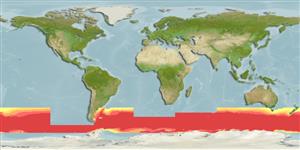Environment: milieu / climate zone / depth range / distribution range
Ecologia
marinhas batipelágico; oceanódromo (Ref. 5182); intervalo de profundidade 1 - 1008 m (Ref. 114491), usually 100 - 350 m (Ref. 4066). Deep-water; 39°S - 69°S, 180°W - 180°E (Ref. 5182)
Circumglobal between the Subtropical Convergence and Antarctic Polar Front.
Length at first maturity / Tamanho / Peso / Idade
Maturity: Lm 8.3 range ? - ? cm
Max length : 11.2 cm SL macho/indeterminado; (Ref. 114491); 9.6 cm SL (female); peso máx. Publicado: 12.10 g (Ref. 5182); peso máx. Publicado: 12.10 g; Idade máx. registada: 6 anos (Ref. 31516)
Espinhos dorsais (total): 0; Raios dorsais moles (total): 13-15; Espinhos anais 0; Raios anais moles: 18 - 20
Oceanic and mesopelagic, found in the upper 100 m south of 50°S, but below 550 m in the region of Subtropical Convergence (Ref. 4066). Migrates from 80 to 140 m to the surface at about 18h00 with ascent rate of 0.5 m per minute; the descent rate is 1.8 m per minute. Forms the main component of the Deep Scattering Layer in the Pacific sector. Feeds on copepods, hyperiids and euphausiids, but also takes ostracods and gastropods. Eaten by squid and to an insignificant degree, by fishes (Channichthyidae, Notolepis sp.) and birds (Procellariidae).
Life cycle and mating behavior
Maturidade | Reprodução | Desova | Ovos | Fecundidade | Larvas
Hulley, P.A., 1990. Myctophidae. p. 146-178. In O. Gon and P.C. Heemstra (eds.) Fishes of the Southern Ocean. J.L.B. Smith Institute of Ichthyology, Grahamstown, South Africa. (Ref. 5182)
Categoria na Lista Vermelha da IUCN (Ref. 130435)
Ameaça para o homem
Harmless
Utilização humana
Mais informação
ColaboradoresFotografiasStamps, Coins Misc.SonsCiguateraVelocidadeTipo de nataçãoÁrea branquialOutras referênciasCérebrosVisão
Ferramentas
Relatórios especiais
Descarregue XML
Fontes da internet
Estimates based on models
Preferred temperature (Ref.
123201): -1.3 - 2.4, mean 0.7 °C (based on 31 cells).
Phylogenetic diversity index (Ref.
82804): PD
50 = 0.5312 [Uniqueness, from 0.5 = low to 2.0 = high].
Bayesian length-weight: a=0.00692 (0.00297 - 0.01609), b=3.13 (2.93 - 3.33), in cm total length, based on LWR estimates for this (Sub)family-body shape (Ref.
93245).
Nível Trófico (Ref.
69278): 3.2 ±0.0 se; based on diet studies.
Generation time: 2.0 ( na - na) years. Estimated as median ln(3)/K based on 1
growth studies.
Resiliência (Ref.
120179): Médio, tempo mínimo de duplicação da população 1,4 - 4,4 anos (K=0.55; tmax=5.5).
Fishing Vulnerability (Ref.
59153): Low vulnerability (24 of 100).
Nutrients (Ref.
124155): Calcium = 101 [28, 274] mg/100g; Iron = 0.564 [0.211, 1.748] mg/100g; Protein = 15.9 [14.2, 17.7] %; Omega3 = 0.312 [0.105, 0.898] g/100g; Selenium = 14.1 [4.4, 45.1] μg/100g; VitaminA = 70.5 [8.4, 565.3] μg/100g; Zinc = 0.808 [0.411, 1.717] mg/100g (wet weight); based on
nutrient studies. 